An Analysis of the Economic Factors Behind Compass Airlines' Failure
VerifiedAdded on 2022/08/21
|12
|2755
|26
Report
AI Summary
This report analyzes the failure of Compass Airlines, Australia's first low-cost carrier, following the deregulation of the Australian airline industry in 1990. The report investigates the economic factors contributing to the collapse of Compass Airlines I and II, comparing their failures with the subsequent success of Virgin Blue and Jetstar. It explores key issues such as undercapitalization, predatory pricing, terminal facility access, and financial management, using aviation economics principles. The analysis includes the impact of the duopoly that existed before deregulation, the competitive strategies of Compass Airlines, and the external factors that influenced its operations. The report also provides recommendations on what Compass Airlines' leaders could have done differently to avoid collapse, including avoiding predatory pricing, solving terminal facility issues, and improving financial/cash management. The study aims to provide insights into the complexities of the airline industry and the importance of sound economic strategies for success.
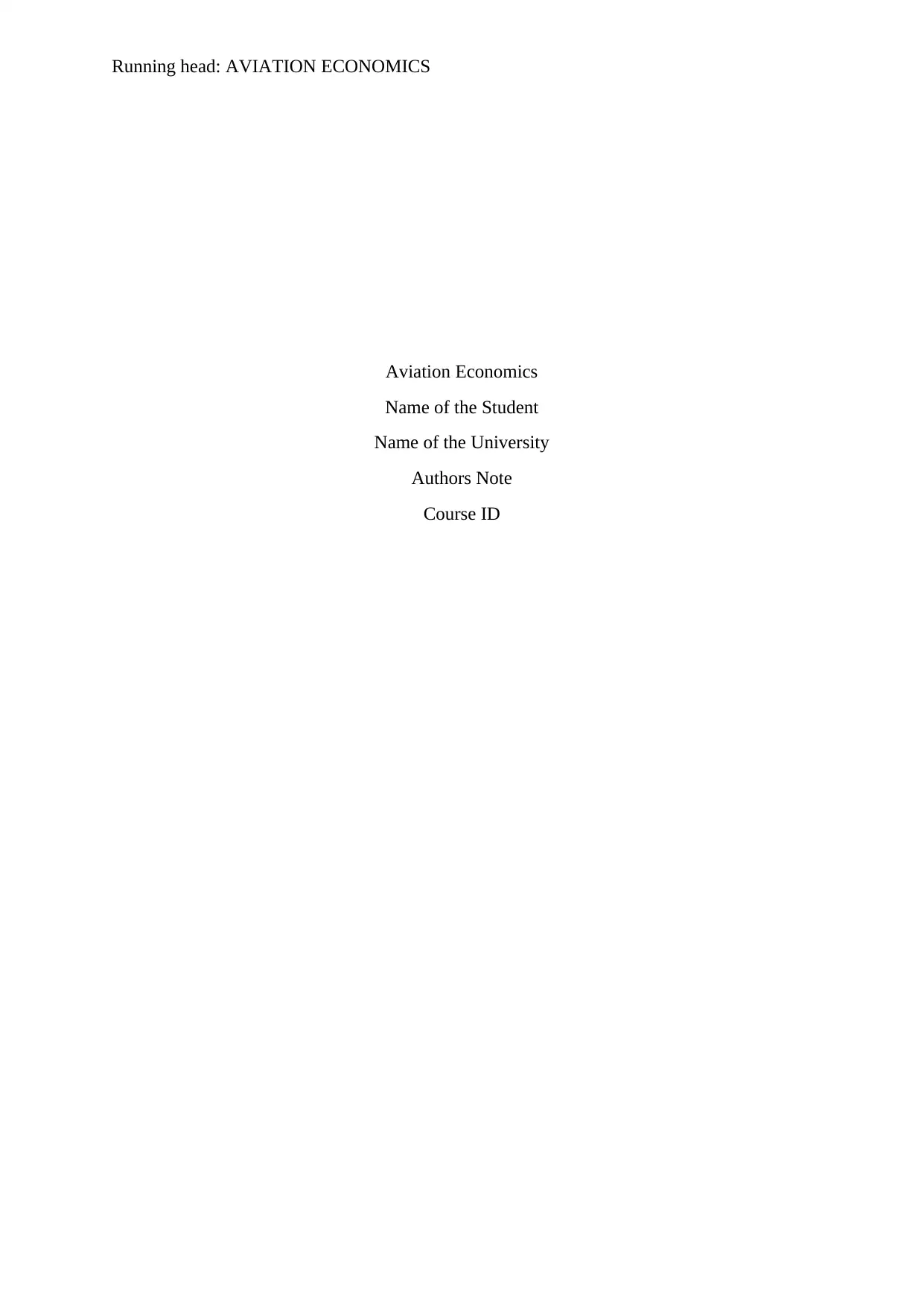
Running head: AVIATION ECONOMICS
Aviation Economics
Name of the Student
Name of the University
Authors Note
Course ID
Aviation Economics
Name of the Student
Name of the University
Authors Note
Course ID
Paraphrase This Document
Need a fresh take? Get an instant paraphrase of this document with our AI Paraphraser
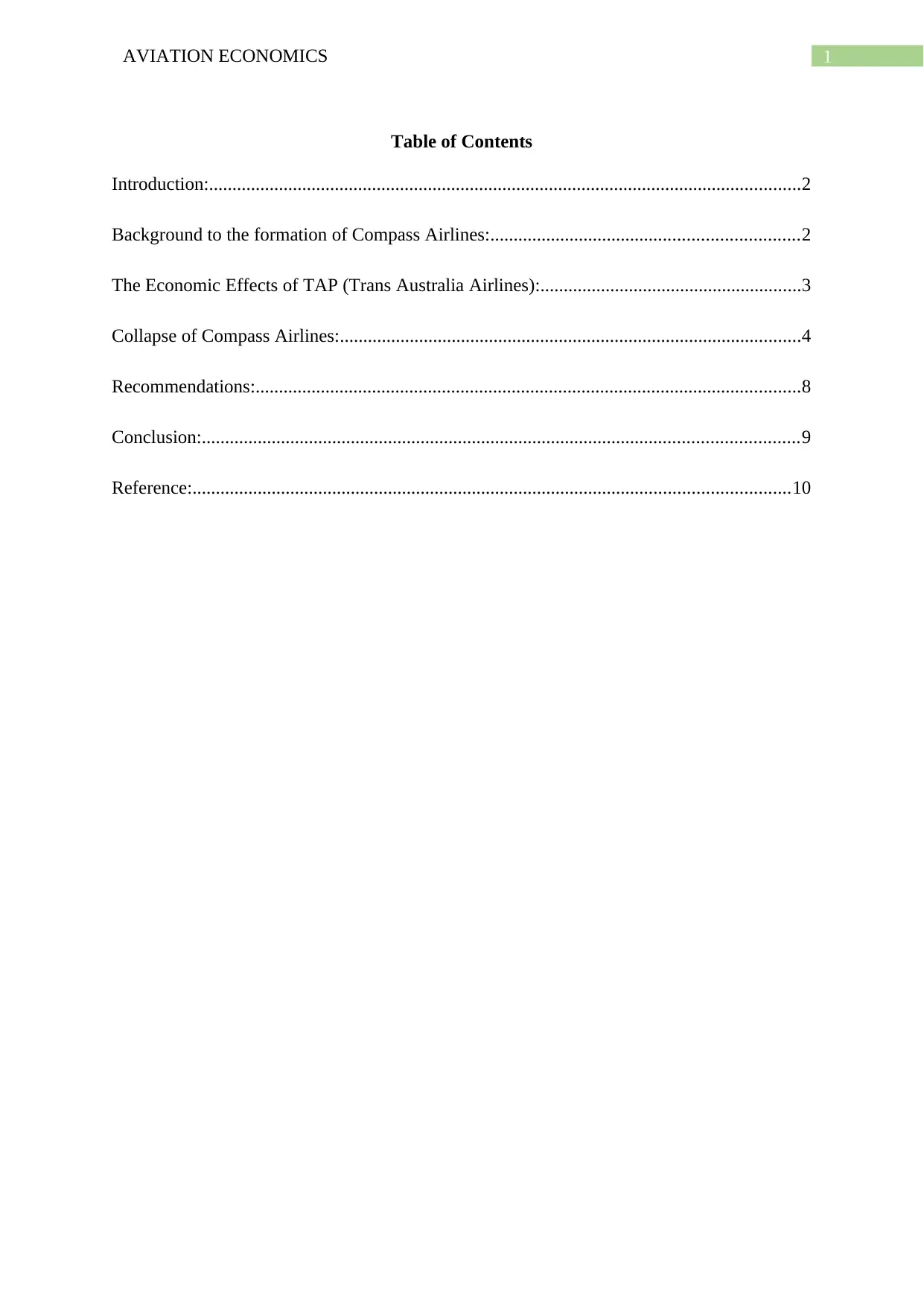
1AVIATION ECONOMICS
Table of Contents
Introduction:...............................................................................................................................2
Background to the formation of Compass Airlines:..................................................................2
The Economic Effects of TAP (Trans Australia Airlines):........................................................3
Collapse of Compass Airlines:...................................................................................................4
Recommendations:.....................................................................................................................8
Conclusion:................................................................................................................................9
Reference:................................................................................................................................10
Table of Contents
Introduction:...............................................................................................................................2
Background to the formation of Compass Airlines:..................................................................2
The Economic Effects of TAP (Trans Australia Airlines):........................................................3
Collapse of Compass Airlines:...................................................................................................4
Recommendations:.....................................................................................................................8
Conclusion:................................................................................................................................9
Reference:................................................................................................................................10
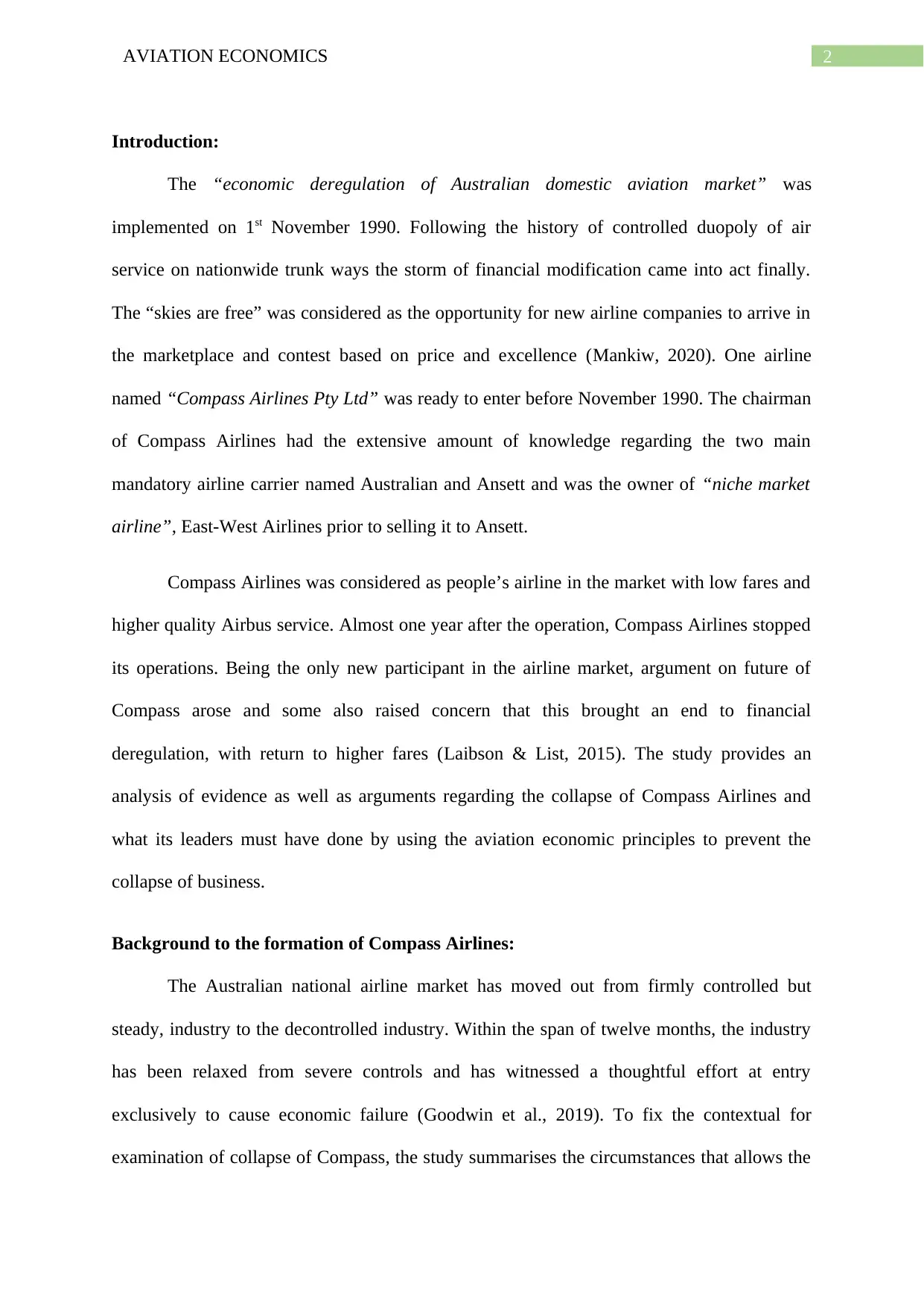
2AVIATION ECONOMICS
Introduction:
The “economic deregulation of Australian domestic aviation market” was
implemented on 1st November 1990. Following the history of controlled duopoly of air
service on nationwide trunk ways the storm of financial modification came into act finally.
The “skies are free” was considered as the opportunity for new airline companies to arrive in
the marketplace and contest based on price and excellence (Mankiw, 2020). One airline
named “Compass Airlines Pty Ltd” was ready to enter before November 1990. The chairman
of Compass Airlines had the extensive amount of knowledge regarding the two main
mandatory airline carrier named Australian and Ansett and was the owner of “niche market
airline”, East-West Airlines prior to selling it to Ansett.
Compass Airlines was considered as people’s airline in the market with low fares and
higher quality Airbus service. Almost one year after the operation, Compass Airlines stopped
its operations. Being the only new participant in the airline market, argument on future of
Compass arose and some also raised concern that this brought an end to financial
deregulation, with return to higher fares (Laibson & List, 2015). The study provides an
analysis of evidence as well as arguments regarding the collapse of Compass Airlines and
what its leaders must have done by using the aviation economic principles to prevent the
collapse of business.
Background to the formation of Compass Airlines:
The Australian national airline market has moved out from firmly controlled but
steady, industry to the decontrolled industry. Within the span of twelve months, the industry
has been relaxed from severe controls and has witnessed a thoughtful effort at entry
exclusively to cause economic failure (Goodwin et al., 2019). To fix the contextual for
examination of collapse of Compass, the study summarises the circumstances that allows the
Introduction:
The “economic deregulation of Australian domestic aviation market” was
implemented on 1st November 1990. Following the history of controlled duopoly of air
service on nationwide trunk ways the storm of financial modification came into act finally.
The “skies are free” was considered as the opportunity for new airline companies to arrive in
the marketplace and contest based on price and excellence (Mankiw, 2020). One airline
named “Compass Airlines Pty Ltd” was ready to enter before November 1990. The chairman
of Compass Airlines had the extensive amount of knowledge regarding the two main
mandatory airline carrier named Australian and Ansett and was the owner of “niche market
airline”, East-West Airlines prior to selling it to Ansett.
Compass Airlines was considered as people’s airline in the market with low fares and
higher quality Airbus service. Almost one year after the operation, Compass Airlines stopped
its operations. Being the only new participant in the airline market, argument on future of
Compass arose and some also raised concern that this brought an end to financial
deregulation, with return to higher fares (Laibson & List, 2015). The study provides an
analysis of evidence as well as arguments regarding the collapse of Compass Airlines and
what its leaders must have done by using the aviation economic principles to prevent the
collapse of business.
Background to the formation of Compass Airlines:
The Australian national airline market has moved out from firmly controlled but
steady, industry to the decontrolled industry. Within the span of twelve months, the industry
has been relaxed from severe controls and has witnessed a thoughtful effort at entry
exclusively to cause economic failure (Goodwin et al., 2019). To fix the contextual for
examination of collapse of Compass, the study summarises the circumstances that allows the
⊘ This is a preview!⊘
Do you want full access?
Subscribe today to unlock all pages.

Trusted by 1+ million students worldwide
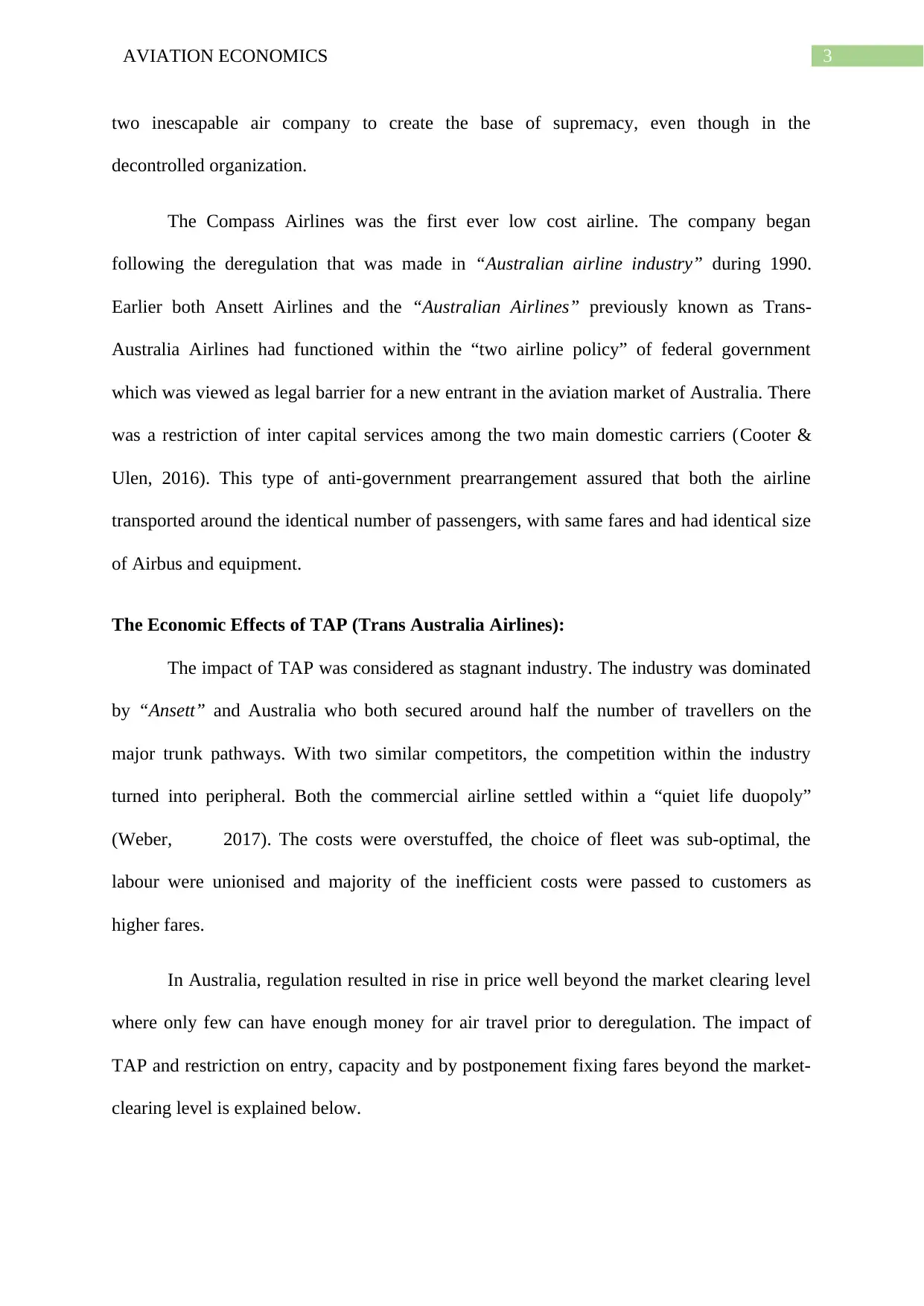
3AVIATION ECONOMICS
two inescapable air company to create the base of supremacy, even though in the
decontrolled organization.
The Compass Airlines was the first ever low cost airline. The company began
following the deregulation that was made in “Australian airline industry” during 1990.
Earlier both Ansett Airlines and the “Australian Airlines” previously known as Trans-
Australia Airlines had functioned within the “two airline policy” of federal government
which was viewed as legal barrier for a new entrant in the aviation market of Australia. There
was a restriction of inter capital services among the two main domestic carriers (Cooter &
Ulen, 2016). This type of anti-government prearrangement assured that both the airline
transported around the identical number of passengers, with same fares and had identical size
of Airbus and equipment.
The Economic Effects of TAP (Trans Australia Airlines):
The impact of TAP was considered as stagnant industry. The industry was dominated
by “Ansett” and Australia who both secured around half the number of travellers on the
major trunk pathways. With two similar competitors, the competition within the industry
turned into peripheral. Both the commercial airline settled within a “quiet life duopoly”
(Weber, 2017). The costs were overstuffed, the choice of fleet was sub-optimal, the
labour were unionised and majority of the inefficient costs were passed to customers as
higher fares.
In Australia, regulation resulted in rise in price well beyond the market clearing level
where only few can have enough money for air travel prior to deregulation. The impact of
TAP and restriction on entry, capacity and by postponement fixing fares beyond the market-
clearing level is explained below.
two inescapable air company to create the base of supremacy, even though in the
decontrolled organization.
The Compass Airlines was the first ever low cost airline. The company began
following the deregulation that was made in “Australian airline industry” during 1990.
Earlier both Ansett Airlines and the “Australian Airlines” previously known as Trans-
Australia Airlines had functioned within the “two airline policy” of federal government
which was viewed as legal barrier for a new entrant in the aviation market of Australia. There
was a restriction of inter capital services among the two main domestic carriers (Cooter &
Ulen, 2016). This type of anti-government prearrangement assured that both the airline
transported around the identical number of passengers, with same fares and had identical size
of Airbus and equipment.
The Economic Effects of TAP (Trans Australia Airlines):
The impact of TAP was considered as stagnant industry. The industry was dominated
by “Ansett” and Australia who both secured around half the number of travellers on the
major trunk pathways. With two similar competitors, the competition within the industry
turned into peripheral. Both the commercial airline settled within a “quiet life duopoly”
(Weber, 2017). The costs were overstuffed, the choice of fleet was sub-optimal, the
labour were unionised and majority of the inefficient costs were passed to customers as
higher fares.
In Australia, regulation resulted in rise in price well beyond the market clearing level
where only few can have enough money for air travel prior to deregulation. The impact of
TAP and restriction on entry, capacity and by postponement fixing fares beyond the market-
clearing level is explained below.
Paraphrase This Document
Need a fresh take? Get an instant paraphrase of this document with our AI Paraphraser
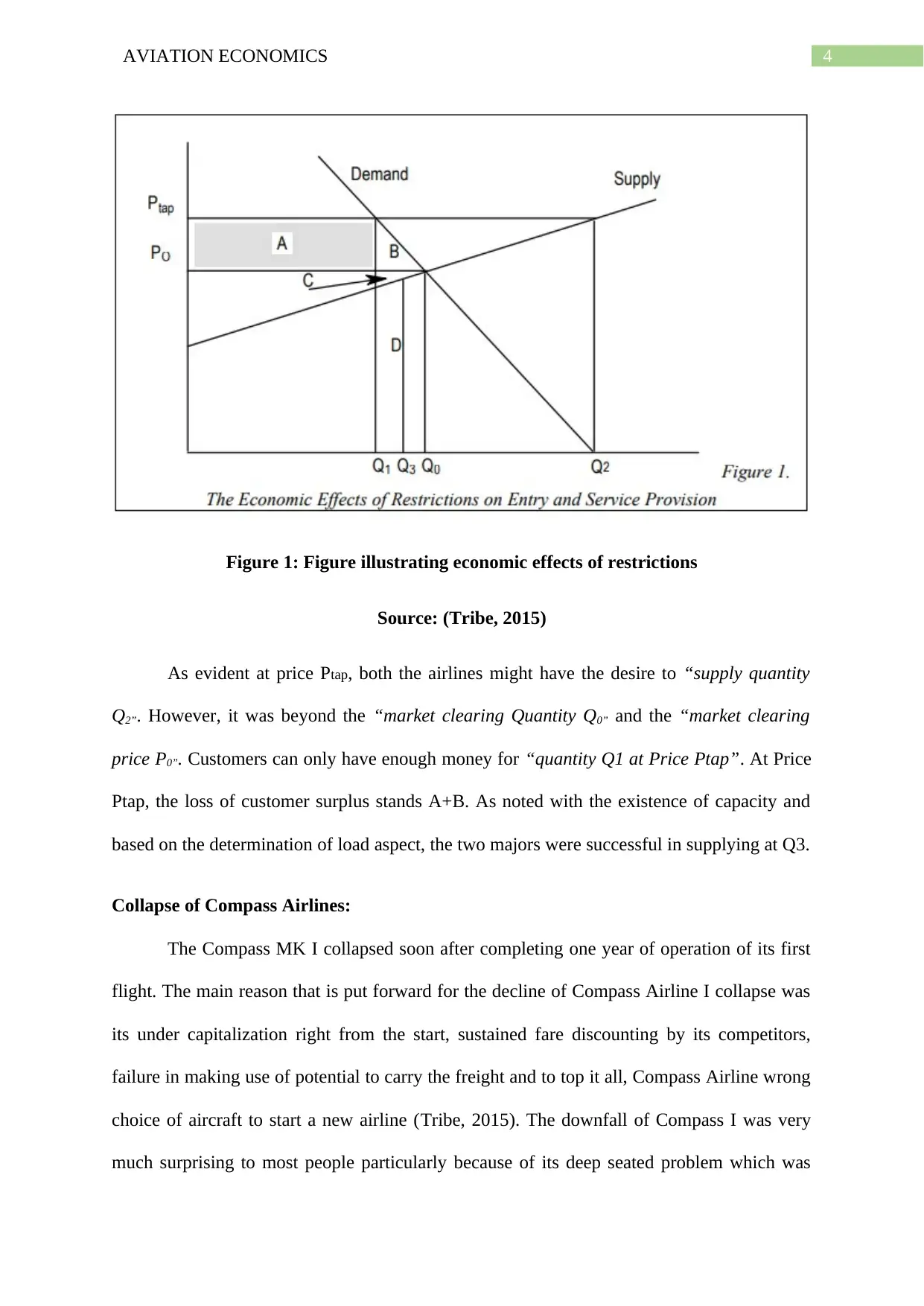
4AVIATION ECONOMICS
Figure 1: Figure illustrating economic effects of restrictions
Source: (Tribe, 2015)
As evident at price Ptap, both the airlines might have the desire to “supply quantity
Q2”. However, it was beyond the “market clearing Quantity Q0” and the “market clearing
price P0”. Customers can only have enough money for “quantity Q1 at Price Ptap”. At Price
Ptap, the loss of customer surplus stands A+B. As noted with the existence of capacity and
based on the determination of load aspect, the two majors were successful in supplying at Q3.
Collapse of Compass Airlines:
The Compass MK I collapsed soon after completing one year of operation of its first
flight. The main reason that is put forward for the decline of Compass Airline I collapse was
its under capitalization right from the start, sustained fare discounting by its competitors,
failure in making use of potential to carry the freight and to top it all, Compass Airline wrong
choice of aircraft to start a new airline (Tribe, 2015). The downfall of Compass I was very
much surprising to most people particularly because of its deep seated problem which was
Figure 1: Figure illustrating economic effects of restrictions
Source: (Tribe, 2015)
As evident at price Ptap, both the airlines might have the desire to “supply quantity
Q2”. However, it was beyond the “market clearing Quantity Q0” and the “market clearing
price P0”. Customers can only have enough money for “quantity Q1 at Price Ptap”. At Price
Ptap, the loss of customer surplus stands A+B. As noted with the existence of capacity and
based on the determination of load aspect, the two majors were successful in supplying at Q3.
Collapse of Compass Airlines:
The Compass MK I collapsed soon after completing one year of operation of its first
flight. The main reason that is put forward for the decline of Compass Airline I collapse was
its under capitalization right from the start, sustained fare discounting by its competitors,
failure in making use of potential to carry the freight and to top it all, Compass Airline wrong
choice of aircraft to start a new airline (Tribe, 2015). The downfall of Compass I was very
much surprising to most people particularly because of its deep seated problem which was
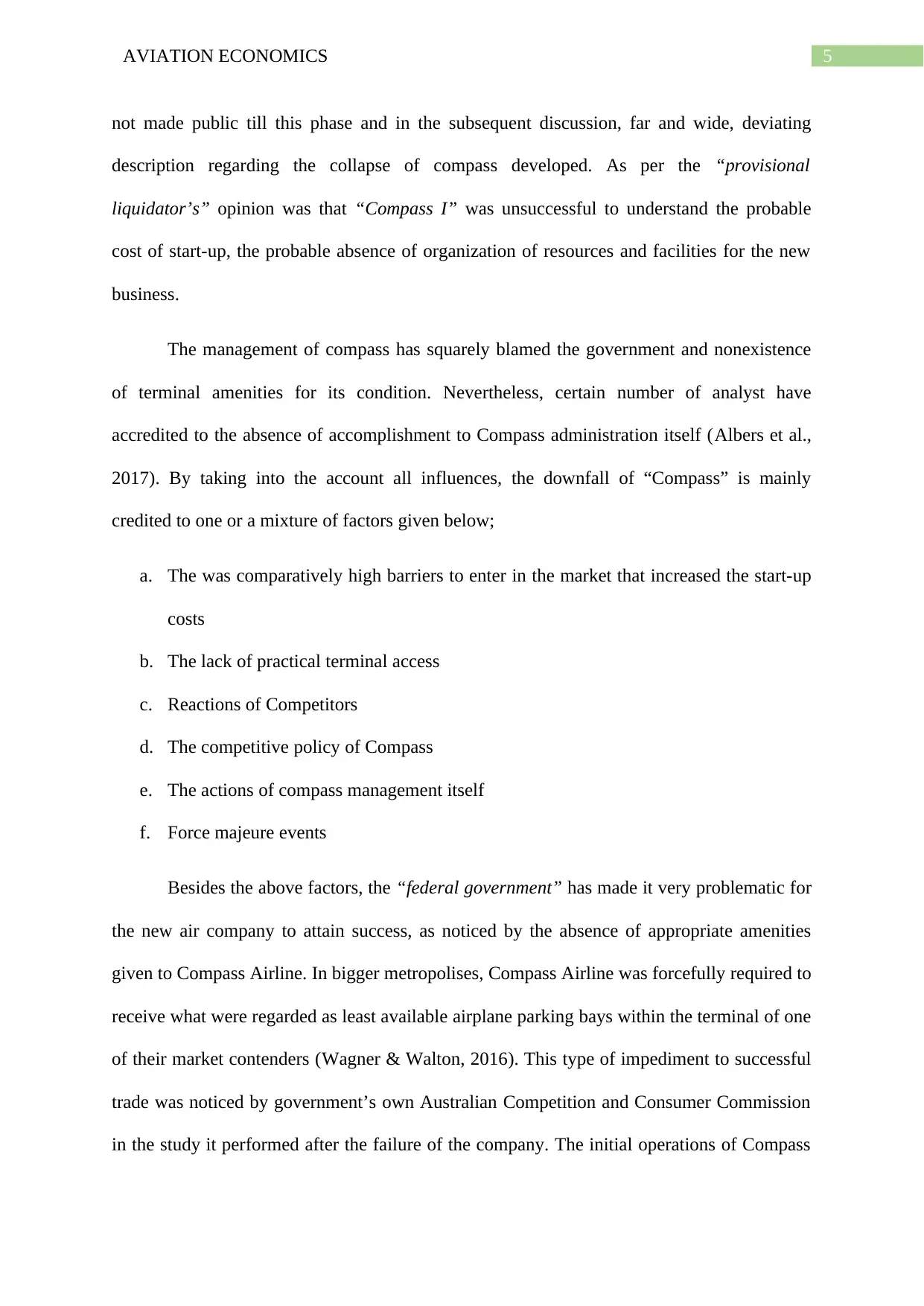
5AVIATION ECONOMICS
not made public till this phase and in the subsequent discussion, far and wide, deviating
description regarding the collapse of compass developed. As per the “provisional
liquidator’s” opinion was that “Compass I” was unsuccessful to understand the probable
cost of start-up, the probable absence of organization of resources and facilities for the new
business.
The management of compass has squarely blamed the government and nonexistence
of terminal amenities for its condition. Nevertheless, certain number of analyst have
accredited to the absence of accomplishment to Compass administration itself (Albers et al.,
2017). By taking into the account all influences, the downfall of “Compass” is mainly
credited to one or a mixture of factors given below;
a. The was comparatively high barriers to enter in the market that increased the start-up
costs
b. The lack of practical terminal access
c. Reactions of Competitors
d. The competitive policy of Compass
e. The actions of compass management itself
f. Force majeure events
Besides the above factors, the “federal government” has made it very problematic for
the new air company to attain success, as noticed by the absence of appropriate amenities
given to Compass Airline. In bigger metropolises, Compass Airline was forcefully required to
receive what were regarded as least available airplane parking bays within the terminal of one
of their market contenders (Wagner & Walton, 2016). This type of impediment to successful
trade was noticed by government’s own Australian Competition and Consumer Commission
in the study it performed after the failure of the company. The initial operations of Compass
not made public till this phase and in the subsequent discussion, far and wide, deviating
description regarding the collapse of compass developed. As per the “provisional
liquidator’s” opinion was that “Compass I” was unsuccessful to understand the probable
cost of start-up, the probable absence of organization of resources and facilities for the new
business.
The management of compass has squarely blamed the government and nonexistence
of terminal amenities for its condition. Nevertheless, certain number of analyst have
accredited to the absence of accomplishment to Compass administration itself (Albers et al.,
2017). By taking into the account all influences, the downfall of “Compass” is mainly
credited to one or a mixture of factors given below;
a. The was comparatively high barriers to enter in the market that increased the start-up
costs
b. The lack of practical terminal access
c. Reactions of Competitors
d. The competitive policy of Compass
e. The actions of compass management itself
f. Force majeure events
Besides the above factors, the “federal government” has made it very problematic for
the new air company to attain success, as noticed by the absence of appropriate amenities
given to Compass Airline. In bigger metropolises, Compass Airline was forcefully required to
receive what were regarded as least available airplane parking bays within the terminal of one
of their market contenders (Wagner & Walton, 2016). This type of impediment to successful
trade was noticed by government’s own Australian Competition and Consumer Commission
in the study it performed after the failure of the company. The initial operations of Compass
⊘ This is a preview!⊘
Do you want full access?
Subscribe today to unlock all pages.

Trusted by 1+ million students worldwide
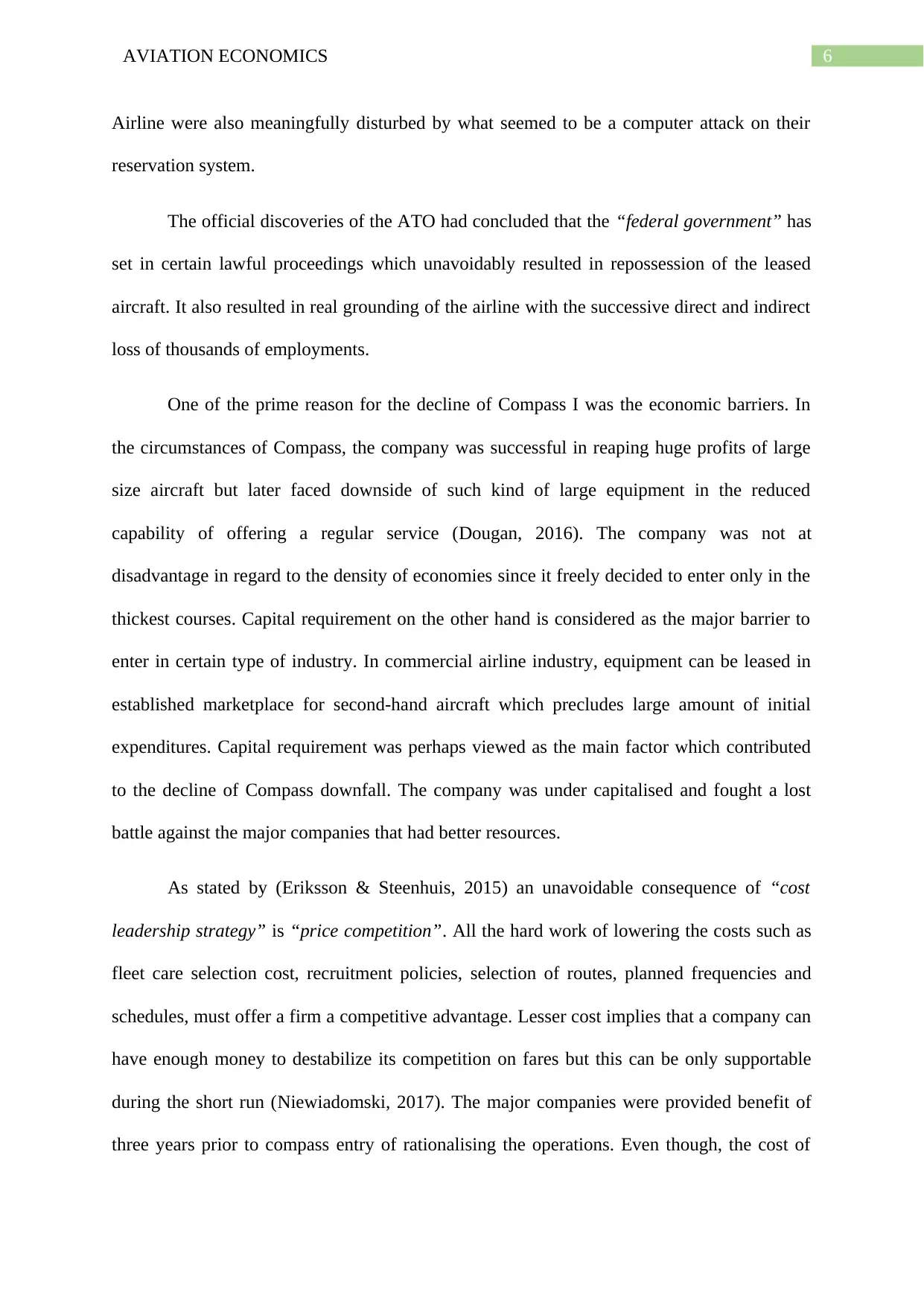
6AVIATION ECONOMICS
Airline were also meaningfully disturbed by what seemed to be a computer attack on their
reservation system.
The official discoveries of the ATO had concluded that the “federal government” has
set in certain lawful proceedings which unavoidably resulted in repossession of the leased
aircraft. It also resulted in real grounding of the airline with the successive direct and indirect
loss of thousands of employments.
One of the prime reason for the decline of Compass I was the economic barriers. In
the circumstances of Compass, the company was successful in reaping huge profits of large
size aircraft but later faced downside of such kind of large equipment in the reduced
capability of offering a regular service (Dougan, 2016). The company was not at
disadvantage in regard to the density of economies since it freely decided to enter only in the
thickest courses. Capital requirement on the other hand is considered as the major barrier to
enter in certain type of industry. In commercial airline industry, equipment can be leased in
established marketplace for second-hand aircraft which precludes large amount of initial
expenditures. Capital requirement was perhaps viewed as the main factor which contributed
to the decline of Compass downfall. The company was under capitalised and fought a lost
battle against the major companies that had better resources.
As stated by (Eriksson & Steenhuis, 2015) an unavoidable consequence of “cost
leadership strategy” is “price competition”. All the hard work of lowering the costs such as
fleet care selection cost, recruitment policies, selection of routes, planned frequencies and
schedules, must offer a firm a competitive advantage. Lesser cost implies that a company can
have enough money to destabilize its competition on fares but this can be only supportable
during the short run (Niewiadomski, 2017). The major companies were provided benefit of
three years prior to compass entry of rationalising the operations. Even though, the cost of
Airline were also meaningfully disturbed by what seemed to be a computer attack on their
reservation system.
The official discoveries of the ATO had concluded that the “federal government” has
set in certain lawful proceedings which unavoidably resulted in repossession of the leased
aircraft. It also resulted in real grounding of the airline with the successive direct and indirect
loss of thousands of employments.
One of the prime reason for the decline of Compass I was the economic barriers. In
the circumstances of Compass, the company was successful in reaping huge profits of large
size aircraft but later faced downside of such kind of large equipment in the reduced
capability of offering a regular service (Dougan, 2016). The company was not at
disadvantage in regard to the density of economies since it freely decided to enter only in the
thickest courses. Capital requirement on the other hand is considered as the major barrier to
enter in certain type of industry. In commercial airline industry, equipment can be leased in
established marketplace for second-hand aircraft which precludes large amount of initial
expenditures. Capital requirement was perhaps viewed as the main factor which contributed
to the decline of Compass downfall. The company was under capitalised and fought a lost
battle against the major companies that had better resources.
As stated by (Eriksson & Steenhuis, 2015) an unavoidable consequence of “cost
leadership strategy” is “price competition”. All the hard work of lowering the costs such as
fleet care selection cost, recruitment policies, selection of routes, planned frequencies and
schedules, must offer a firm a competitive advantage. Lesser cost implies that a company can
have enough money to destabilize its competition on fares but this can be only supportable
during the short run (Niewiadomski, 2017). The major companies were provided benefit of
three years prior to compass entry of rationalising the operations. Even though, the cost of
Paraphrase This Document
Need a fresh take? Get an instant paraphrase of this document with our AI Paraphraser
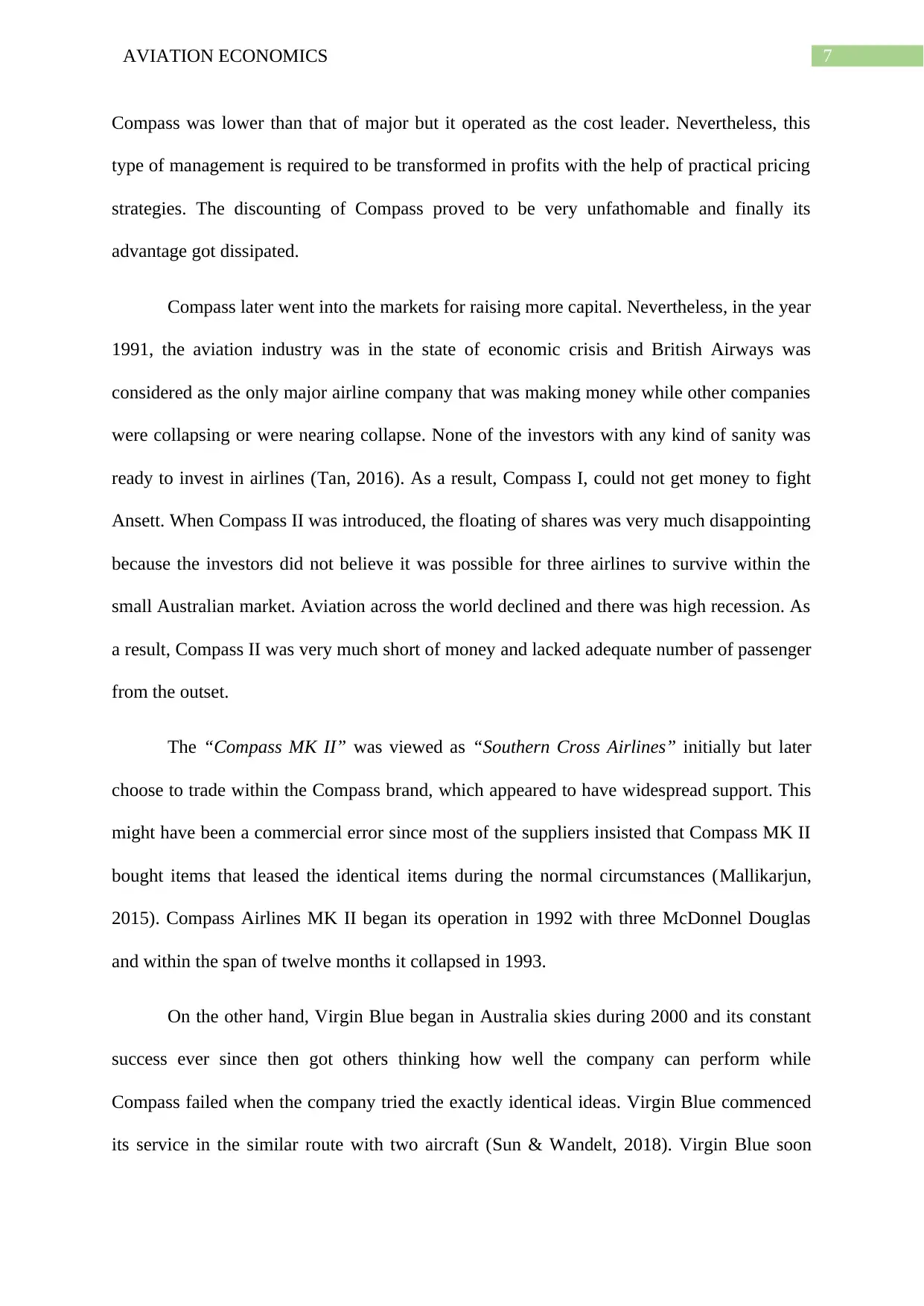
7AVIATION ECONOMICS
Compass was lower than that of major but it operated as the cost leader. Nevertheless, this
type of management is required to be transformed in profits with the help of practical pricing
strategies. The discounting of Compass proved to be very unfathomable and finally its
advantage got dissipated.
Compass later went into the markets for raising more capital. Nevertheless, in the year
1991, the aviation industry was in the state of economic crisis and British Airways was
considered as the only major airline company that was making money while other companies
were collapsing or were nearing collapse. None of the investors with any kind of sanity was
ready to invest in airlines (Tan, 2016). As a result, Compass I, could not get money to fight
Ansett. When Compass II was introduced, the floating of shares was very much disappointing
because the investors did not believe it was possible for three airlines to survive within the
small Australian market. Aviation across the world declined and there was high recession. As
a result, Compass II was very much short of money and lacked adequate number of passenger
from the outset.
The “Compass MK II” was viewed as “Southern Cross Airlines” initially but later
choose to trade within the Compass brand, which appeared to have widespread support. This
might have been a commercial error since most of the suppliers insisted that Compass MK II
bought items that leased the identical items during the normal circumstances (Mallikarjun,
2015). Compass Airlines MK II began its operation in 1992 with three McDonnel Douglas
and within the span of twelve months it collapsed in 1993.
On the other hand, Virgin Blue began in Australia skies during 2000 and its constant
success ever since then got others thinking how well the company can perform while
Compass failed when the company tried the exactly identical ideas. Virgin Blue commenced
its service in the similar route with two aircraft (Sun & Wandelt, 2018). Virgin Blue soon
Compass was lower than that of major but it operated as the cost leader. Nevertheless, this
type of management is required to be transformed in profits with the help of practical pricing
strategies. The discounting of Compass proved to be very unfathomable and finally its
advantage got dissipated.
Compass later went into the markets for raising more capital. Nevertheless, in the year
1991, the aviation industry was in the state of economic crisis and British Airways was
considered as the only major airline company that was making money while other companies
were collapsing or were nearing collapse. None of the investors with any kind of sanity was
ready to invest in airlines (Tan, 2016). As a result, Compass I, could not get money to fight
Ansett. When Compass II was introduced, the floating of shares was very much disappointing
because the investors did not believe it was possible for three airlines to survive within the
small Australian market. Aviation across the world declined and there was high recession. As
a result, Compass II was very much short of money and lacked adequate number of passenger
from the outset.
The “Compass MK II” was viewed as “Southern Cross Airlines” initially but later
choose to trade within the Compass brand, which appeared to have widespread support. This
might have been a commercial error since most of the suppliers insisted that Compass MK II
bought items that leased the identical items during the normal circumstances (Mallikarjun,
2015). Compass Airlines MK II began its operation in 1992 with three McDonnel Douglas
and within the span of twelve months it collapsed in 1993.
On the other hand, Virgin Blue began in Australia skies during 2000 and its constant
success ever since then got others thinking how well the company can perform while
Compass failed when the company tried the exactly identical ideas. Virgin Blue commenced
its service in the similar route with two aircraft (Sun & Wandelt, 2018). Virgin Blue soon
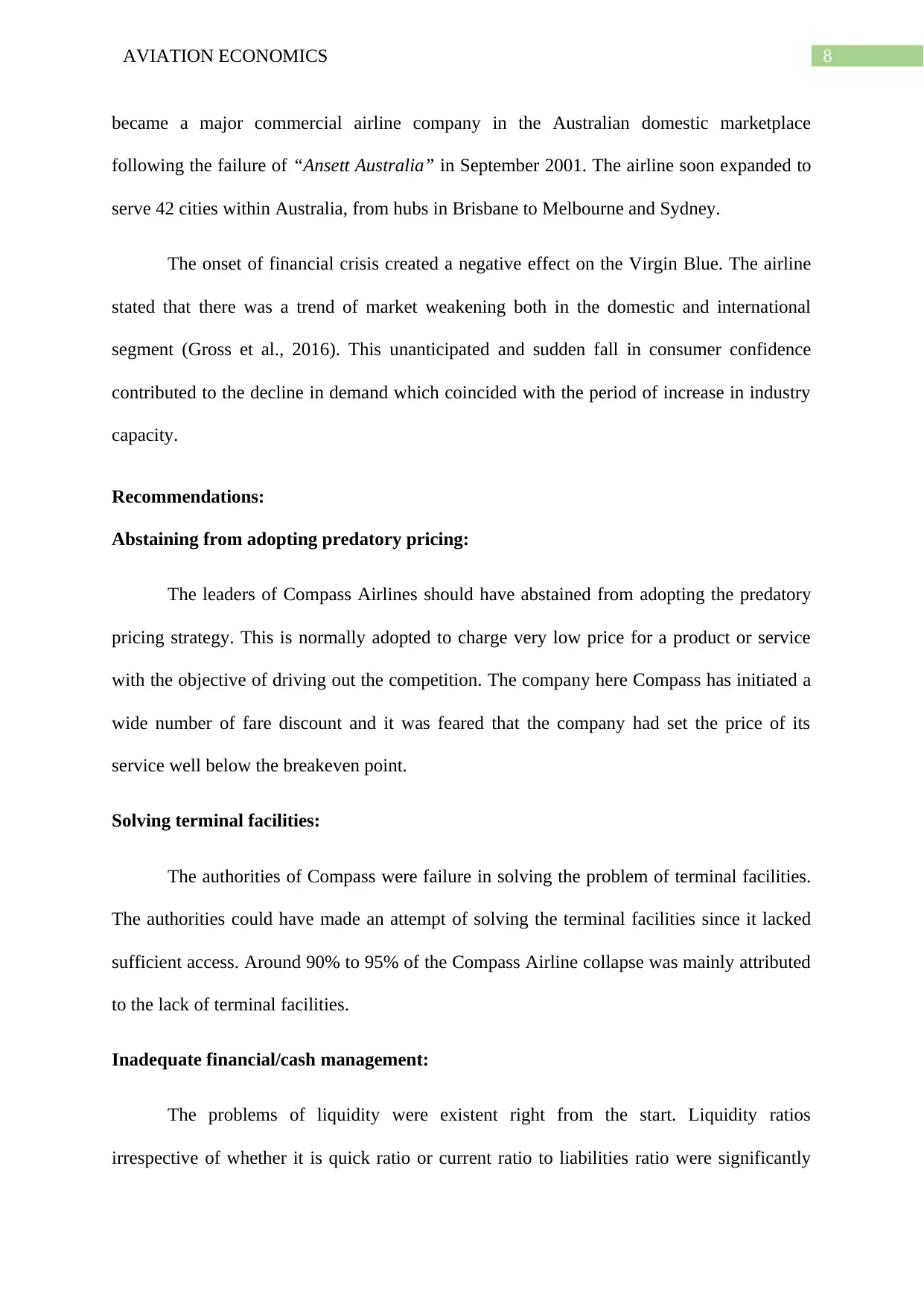
8AVIATION ECONOMICS
became a major commercial airline company in the Australian domestic marketplace
following the failure of “Ansett Australia” in September 2001. The airline soon expanded to
serve 42 cities within Australia, from hubs in Brisbane to Melbourne and Sydney.
The onset of financial crisis created a negative effect on the Virgin Blue. The airline
stated that there was a trend of market weakening both in the domestic and international
segment (Gross et al., 2016). This unanticipated and sudden fall in consumer confidence
contributed to the decline in demand which coincided with the period of increase in industry
capacity.
Recommendations:
Abstaining from adopting predatory pricing:
The leaders of Compass Airlines should have abstained from adopting the predatory
pricing strategy. This is normally adopted to charge very low price for a product or service
with the objective of driving out the competition. The company here Compass has initiated a
wide number of fare discount and it was feared that the company had set the price of its
service well below the breakeven point.
Solving terminal facilities:
The authorities of Compass were failure in solving the problem of terminal facilities.
The authorities could have made an attempt of solving the terminal facilities since it lacked
sufficient access. Around 90% to 95% of the Compass Airline collapse was mainly attributed
to the lack of terminal facilities.
Inadequate financial/cash management:
The problems of liquidity were existent right from the start. Liquidity ratios
irrespective of whether it is quick ratio or current ratio to liabilities ratio were significantly
became a major commercial airline company in the Australian domestic marketplace
following the failure of “Ansett Australia” in September 2001. The airline soon expanded to
serve 42 cities within Australia, from hubs in Brisbane to Melbourne and Sydney.
The onset of financial crisis created a negative effect on the Virgin Blue. The airline
stated that there was a trend of market weakening both in the domestic and international
segment (Gross et al., 2016). This unanticipated and sudden fall in consumer confidence
contributed to the decline in demand which coincided with the period of increase in industry
capacity.
Recommendations:
Abstaining from adopting predatory pricing:
The leaders of Compass Airlines should have abstained from adopting the predatory
pricing strategy. This is normally adopted to charge very low price for a product or service
with the objective of driving out the competition. The company here Compass has initiated a
wide number of fare discount and it was feared that the company had set the price of its
service well below the breakeven point.
Solving terminal facilities:
The authorities of Compass were failure in solving the problem of terminal facilities.
The authorities could have made an attempt of solving the terminal facilities since it lacked
sufficient access. Around 90% to 95% of the Compass Airline collapse was mainly attributed
to the lack of terminal facilities.
Inadequate financial/cash management:
The problems of liquidity were existent right from the start. Liquidity ratios
irrespective of whether it is quick ratio or current ratio to liabilities ratio were significantly
⊘ This is a preview!⊘
Do you want full access?
Subscribe today to unlock all pages.

Trusted by 1+ million students worldwide
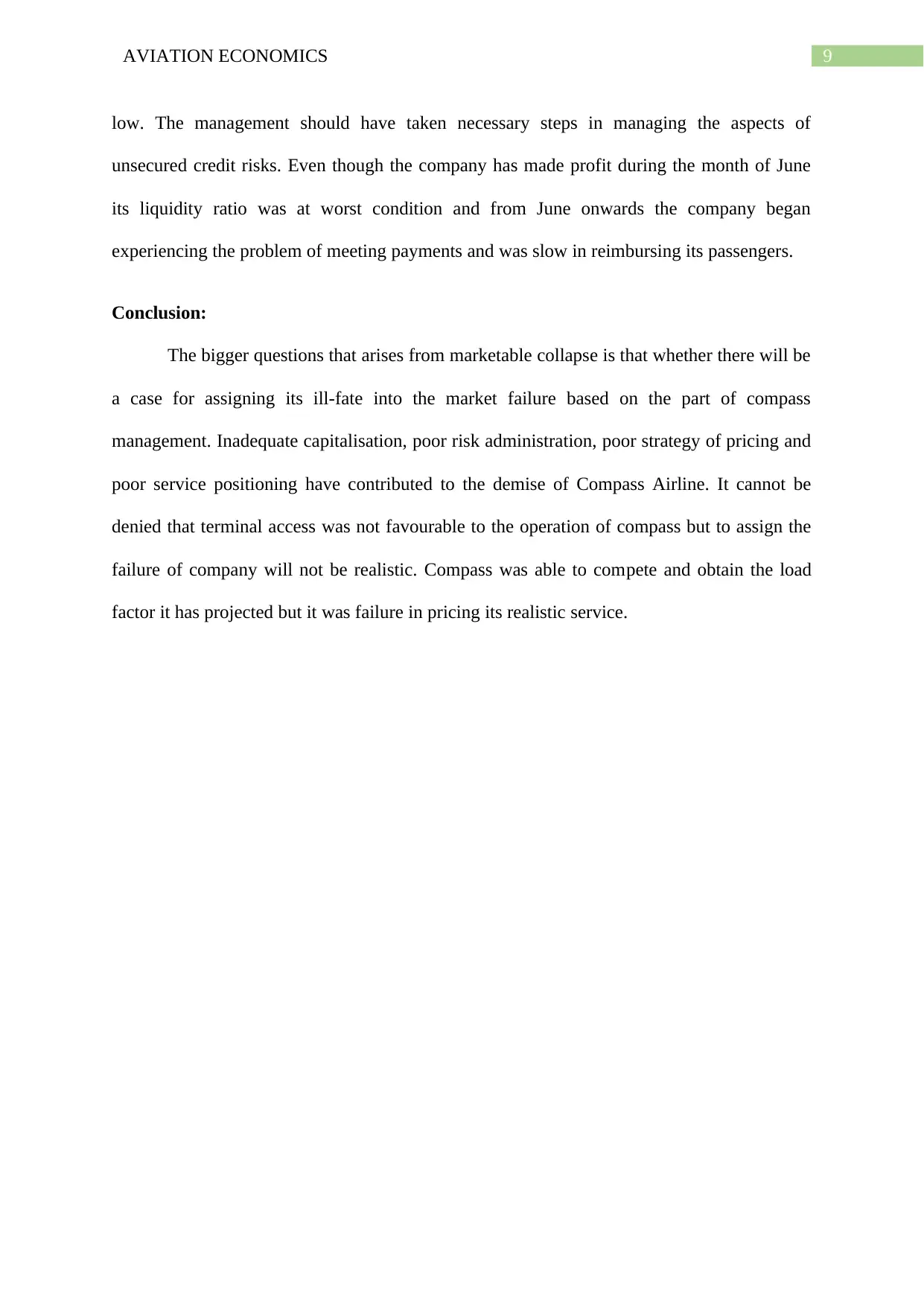
9AVIATION ECONOMICS
low. The management should have taken necessary steps in managing the aspects of
unsecured credit risks. Even though the company has made profit during the month of June
its liquidity ratio was at worst condition and from June onwards the company began
experiencing the problem of meeting payments and was slow in reimbursing its passengers.
Conclusion:
The bigger questions that arises from marketable collapse is that whether there will be
a case for assigning its ill-fate into the market failure based on the part of compass
management. Inadequate capitalisation, poor risk administration, poor strategy of pricing and
poor service positioning have contributed to the demise of Compass Airline. It cannot be
denied that terminal access was not favourable to the operation of compass but to assign the
failure of company will not be realistic. Compass was able to compete and obtain the load
factor it has projected but it was failure in pricing its realistic service.
low. The management should have taken necessary steps in managing the aspects of
unsecured credit risks. Even though the company has made profit during the month of June
its liquidity ratio was at worst condition and from June onwards the company began
experiencing the problem of meeting payments and was slow in reimbursing its passengers.
Conclusion:
The bigger questions that arises from marketable collapse is that whether there will be
a case for assigning its ill-fate into the market failure based on the part of compass
management. Inadequate capitalisation, poor risk administration, poor strategy of pricing and
poor service positioning have contributed to the demise of Compass Airline. It cannot be
denied that terminal access was not favourable to the operation of compass but to assign the
failure of company will not be realistic. Compass was able to compete and obtain the load
factor it has projected but it was failure in pricing its realistic service.
Paraphrase This Document
Need a fresh take? Get an instant paraphrase of this document with our AI Paraphraser
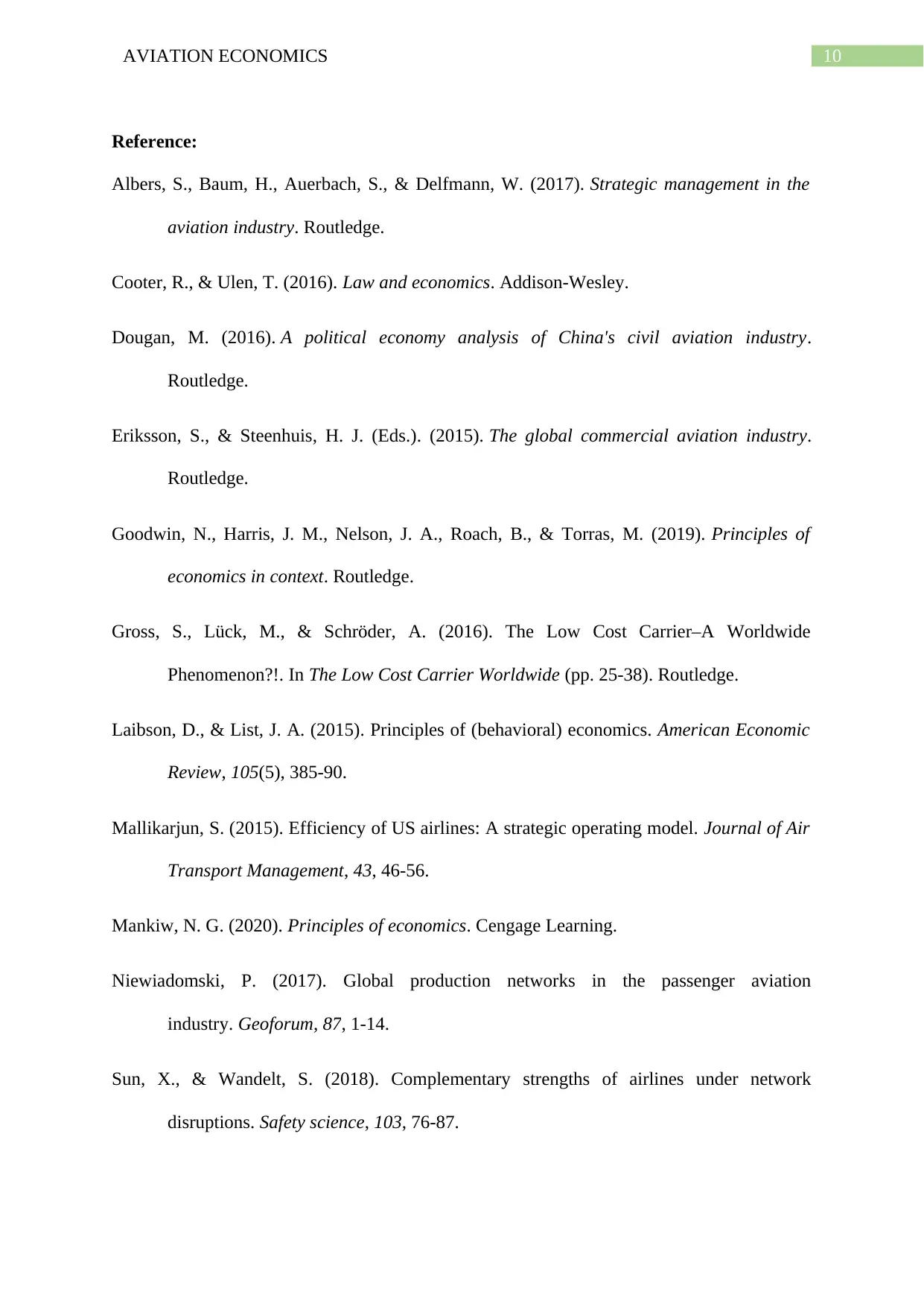
10AVIATION ECONOMICS
Reference:
Albers, S., Baum, H., Auerbach, S., & Delfmann, W. (2017). Strategic management in the
aviation industry. Routledge.
Cooter, R., & Ulen, T. (2016). Law and economics. Addison-Wesley.
Dougan, M. (2016). A political economy analysis of China's civil aviation industry.
Routledge.
Eriksson, S., & Steenhuis, H. J. (Eds.). (2015). The global commercial aviation industry.
Routledge.
Goodwin, N., Harris, J. M., Nelson, J. A., Roach, B., & Torras, M. (2019). Principles of
economics in context. Routledge.
Gross, S., Lück, M., & Schröder, A. (2016). The Low Cost Carrier–A Worldwide
Phenomenon?!. In The Low Cost Carrier Worldwide (pp. 25-38). Routledge.
Laibson, D., & List, J. A. (2015). Principles of (behavioral) economics. American Economic
Review, 105(5), 385-90.
Mallikarjun, S. (2015). Efficiency of US airlines: A strategic operating model. Journal of Air
Transport Management, 43, 46-56.
Mankiw, N. G. (2020). Principles of economics. Cengage Learning.
Niewiadomski, P. (2017). Global production networks in the passenger aviation
industry. Geoforum, 87, 1-14.
Sun, X., & Wandelt, S. (2018). Complementary strengths of airlines under network
disruptions. Safety science, 103, 76-87.
Reference:
Albers, S., Baum, H., Auerbach, S., & Delfmann, W. (2017). Strategic management in the
aviation industry. Routledge.
Cooter, R., & Ulen, T. (2016). Law and economics. Addison-Wesley.
Dougan, M. (2016). A political economy analysis of China's civil aviation industry.
Routledge.
Eriksson, S., & Steenhuis, H. J. (Eds.). (2015). The global commercial aviation industry.
Routledge.
Goodwin, N., Harris, J. M., Nelson, J. A., Roach, B., & Torras, M. (2019). Principles of
economics in context. Routledge.
Gross, S., Lück, M., & Schröder, A. (2016). The Low Cost Carrier–A Worldwide
Phenomenon?!. In The Low Cost Carrier Worldwide (pp. 25-38). Routledge.
Laibson, D., & List, J. A. (2015). Principles of (behavioral) economics. American Economic
Review, 105(5), 385-90.
Mallikarjun, S. (2015). Efficiency of US airlines: A strategic operating model. Journal of Air
Transport Management, 43, 46-56.
Mankiw, N. G. (2020). Principles of economics. Cengage Learning.
Niewiadomski, P. (2017). Global production networks in the passenger aviation
industry. Geoforum, 87, 1-14.
Sun, X., & Wandelt, S. (2018). Complementary strengths of airlines under network
disruptions. Safety science, 103, 76-87.
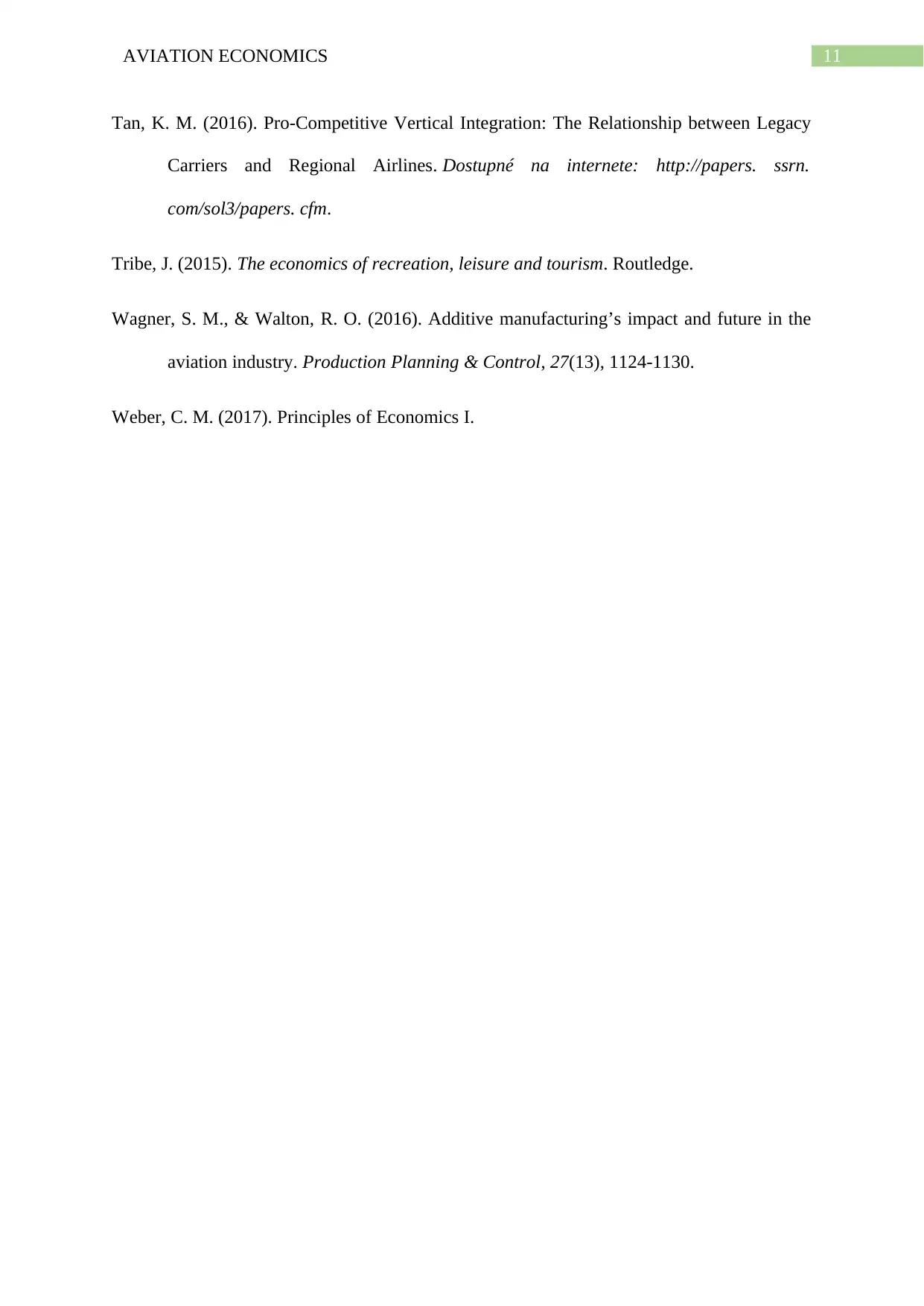
11AVIATION ECONOMICS
Tan, K. M. (2016). Pro-Competitive Vertical Integration: The Relationship between Legacy
Carriers and Regional Airlines. Dostupné na internete: http://papers. ssrn.
com/sol3/papers. cfm.
Tribe, J. (2015). The economics of recreation, leisure and tourism. Routledge.
Wagner, S. M., & Walton, R. O. (2016). Additive manufacturing’s impact and future in the
aviation industry. Production Planning & Control, 27(13), 1124-1130.
Weber, C. M. (2017). Principles of Economics I.
Tan, K. M. (2016). Pro-Competitive Vertical Integration: The Relationship between Legacy
Carriers and Regional Airlines. Dostupné na internete: http://papers. ssrn.
com/sol3/papers. cfm.
Tribe, J. (2015). The economics of recreation, leisure and tourism. Routledge.
Wagner, S. M., & Walton, R. O. (2016). Additive manufacturing’s impact and future in the
aviation industry. Production Planning & Control, 27(13), 1124-1130.
Weber, C. M. (2017). Principles of Economics I.
⊘ This is a preview!⊘
Do you want full access?
Subscribe today to unlock all pages.

Trusted by 1+ million students worldwide
1 out of 12
Related Documents
Your All-in-One AI-Powered Toolkit for Academic Success.
+13062052269
info@desklib.com
Available 24*7 on WhatsApp / Email
![[object Object]](/_next/static/media/star-bottom.7253800d.svg)
Unlock your academic potential
Copyright © 2020–2025 A2Z Services. All Rights Reserved. Developed and managed by ZUCOL.





